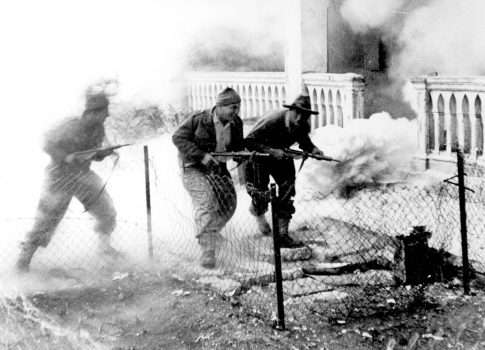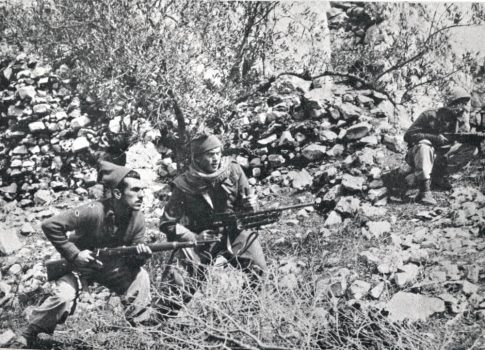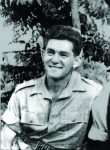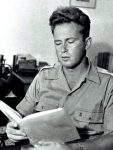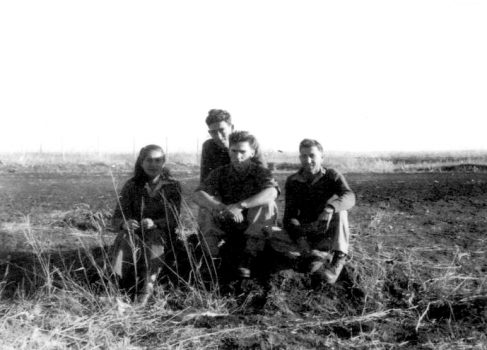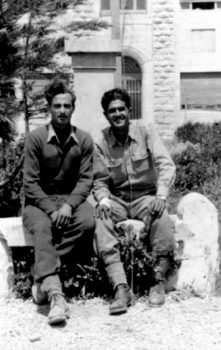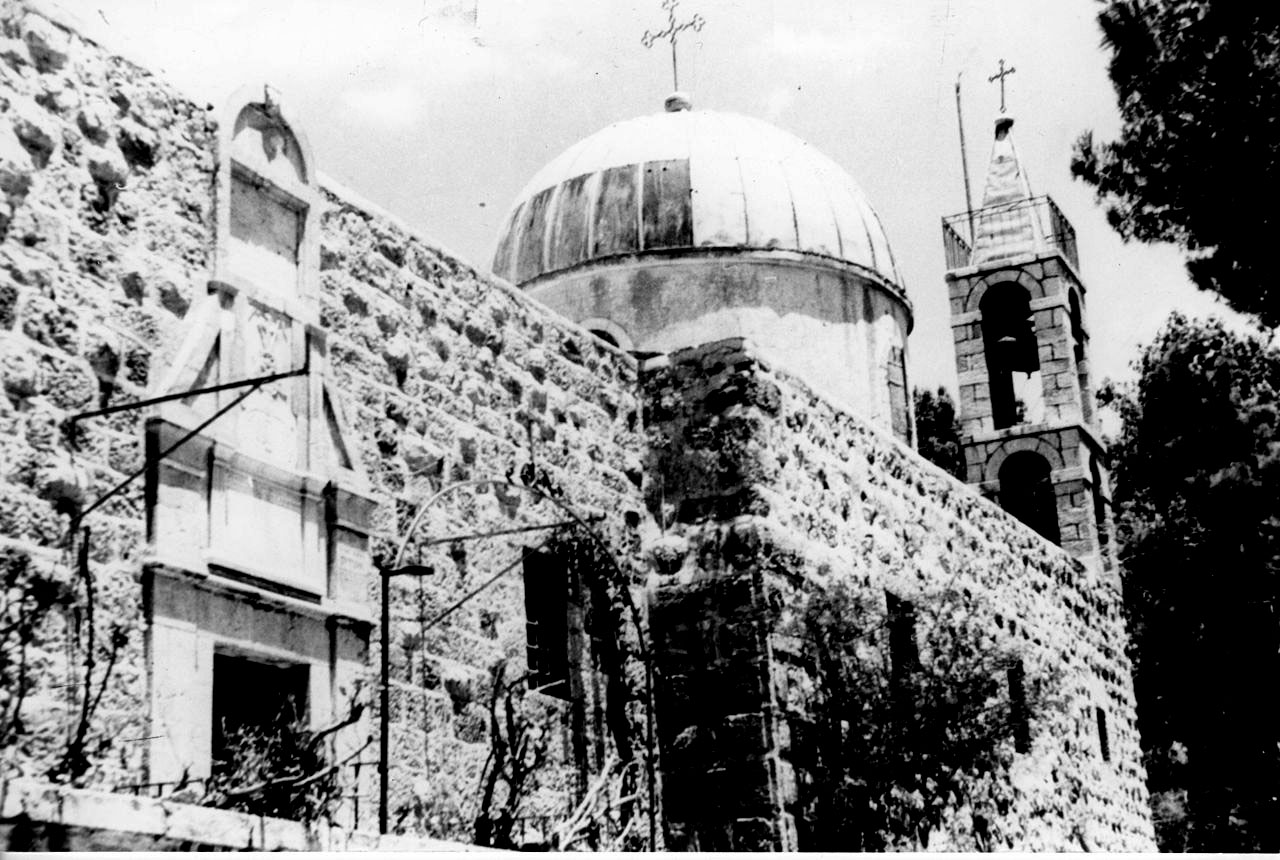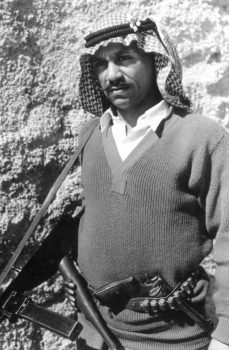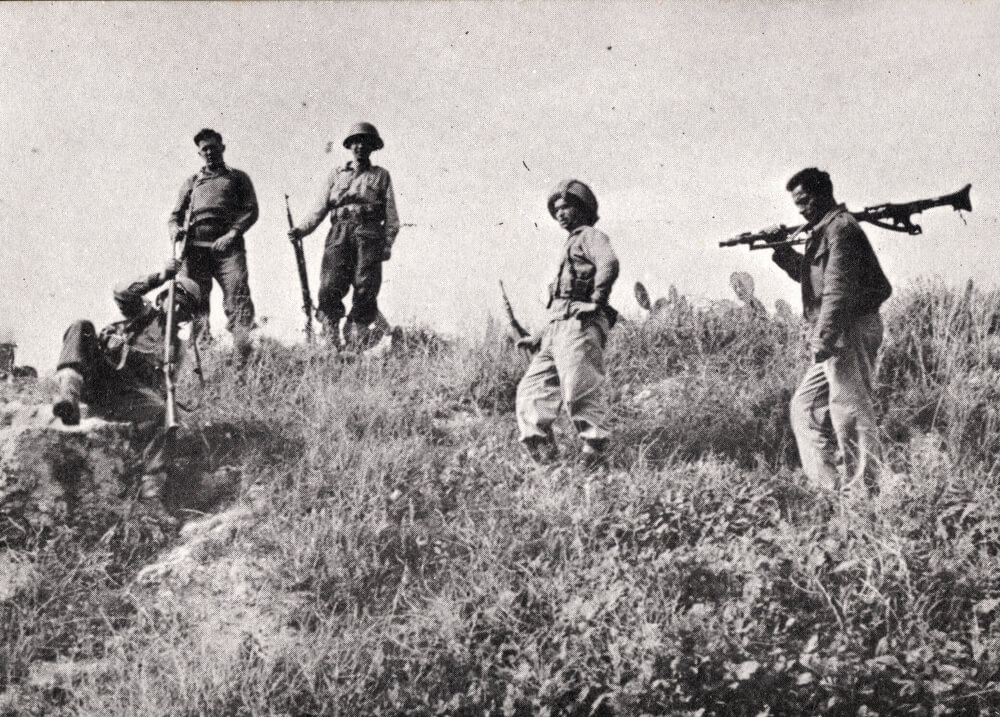Fighting for Jerusalem
In 2003, about a year before Reserves General Rafael Eitan drowned off the coast of Ashdod, he spoke to a group of tour guides on the lawn by San Simon Monastery, in the Jerusalem neighborhood of Katamon. As children played in the background, Raful, as he was affectionately known, explained why future generations had to know the story of the battle he’d fought here during Israel’s War of Independence. “I was shot in the head,” he said, “but half an hour later I was fighting again.”
Speaking at the president of Israel’s residence soon after becoming commander in chief of the Israel Defense Forces in 1978, Raful famously referred to the same episode:
Not far from here, the future of Jerusalem as Israel’s eternal capital was determined in a fierce battle thirty years ago. I was privileged to be part of it, and it’s my privilege to stand here today, in this place, and accept the post of commander in chief. (Tzvika Dror, Harel: The Battle for Jerusalem [Ha-kibbutz Ha-me’uhad, 2005], p. 139 [Hebrew])
The battle for San Simon became one of the most influential in Israeli history. Thousands of soldiers visit the site every year to hear the story, and the battle has been reenacted more than once. Participants in one such simulation, in the 1950s, approach the monastery from the direction of Jerusalem’s Katamon district
Though Eitan was never one to talk, one might have expected that when sworn in to his new post after thirty years’ army service, he would have drawn on a more crucial point in his military career than a minor skirmish predating his officers’ training course. Yet the battle for San Simon was the one he chose.
Raful’s comrades, many later highly influential in the IDF and Israeli life, also saw this battle as a defining event in their careers. Why was it so special? How did San Simon differ from other engagements waged in and around Jerusalem in the War of Independence, and why is it indelibly inscribed in the hearts and minds of those who fought there?
In April 1948, rumors circulated in Mandate Palestine that the British were planning to evacuate their personnel from Jerusalem earlier than expected. Leaders of the Hagana, the civil reserve guard and the largest underground Jewish defense organization, suspected that strategic British positions would then be occupied by Arab forces. Jerusalem commander David Shaltiel resolved to prevent that by bringing reinforcements to the city. He chose a unit from the Palmah, the Hagana’s fighting arm.
Palmach fighters crouch between stone terraces by San Simon Monastery, waiting for the commander to advance
The Harel Brigade, headed by the young Yitzhak Rabin, had been stationed in the Jerusalem Corridor to protect convoys approaching the city. Rabin would have preferred to consolidate Palmah control of the road, Jerusalem’s lifeline, but instead his fighters were organized into the ill-fated Harel convoy. They were ambushed as the road passed through the narrow ravine at Sha’ar Hagai, and fifteen were killed.
The brigade arrived in Jerusalem only to find that the rumors had been false; the British were leaving only at the end of the Mandate, on May 15. Yet Jerusalem was under siege, and Harel’s arrival brought the city’s anxious residents much needed relief and a sense of security.
Shaltiel pondered whether to send the brigade back to the Jerusalem Corridor or keep it in the city for a military operation that had been postponed for lack of manpower. Operation Jebusite, as this contingency plan was called, was a bold series of attacks to prevent Jerusalem’s outlying Jewish neighborhoods from being cut off. The aim was to conquer Sheikh Jarrah, an area dividing the Old City from the Hebrew University on Mount Scopus, as well as the strategic heights of Beit Ikhsa and Nebi Samuel to the north of the city, and San Simon Monastery and Katamon in its south.
The attack on San Simon was the third phase of the operation, after the brigade failed to capture the hill of Nebi Samuel. More than forty Palmah fighters fell in that offensive – on April 22–3, the first day of Pesach – including commander Haim Poznansky and other officers. Overlooking Katamon, San Simon was a wealthy Greek Orthodox monastery of Arab Christians. Whoever controlled it commanded the southern Jewish residential areas of Talpiyot, Mekor Haim, Arnona, and Kibbutz Ramat Rachel, and could easily snipe at nearby Kiryat Shemuel and Rehavia. This whole section of Jewish Jerusalem was liable to be isolated from the central and western parts of the city, leaving its residents vulnerable. The hilltop monastery had to be captured before the rest of the attack could succeed.
At Almost Any Price
The first attempt to seize San Simon was launched on the night of April 26 by the Harel Brigade’s 4th Battalion, but it was rebuffed with heavy fire. After the disaster at Nebi Samuel, Commander Yosef Tabenkin preferred to retreat and put off the attack.
At noon on April 29, the battalion’s staff met in a deserted British courthouse in the nearby Arab neighborhood of Talbieh. Attendees included Tabenkin’s deputy, Uzi Narkiss, and his chief of operations, Eliyahu Sela; two commanders, Uri Ben Ari and Mordechai (Motke) Ben Porat; and various staff. At thirty-five, political commissar Benny Marshak was the oldest of the group but the youngest at heart. Marshak also commanded the auxiliary unit in many of the brigade’s battles and was a source of constant encouragement and motivation for the troops. One of them, author Yoram Konyak, later recalled:
We couldn’t have fought in Nebi Samuel or Katamon without Benny. We were so tired we were falling asleep over our rifles as we shot, but he wasn’t weary. He didn’t sleep a wink. He’d set out to free the world from its shackles, and we followed in his wake. (Arie Hashavia, The Battle for San Simon, [Milo Publishing, 1978], p. 16 [Hebrew])
Tabenkin briefed his staff on the Arab forces in the area. Most were locals led by Ibrahim Abu Dayya, one of Abd al-Qader al-Husseini’s deputy commanders, but there was also an indeterminate number of Iraqi volunteers. All were equipped with light weapons and armored vehicles – some from a Jewish convoy to the Etzion Bloc that had been attacked at Nebi Daniel the month before. Tabenkin made it clear that the monastery had to be conquered at almost any price. Ben Ari wrote:
I couldn’t stop worrying about the commander’s briefing – that the objective had to be achieved at almost any price. That meant the battle had to go on, and we’d have to keep attacking, even with terrible injuries and loss of life. … You knew the moment would come when those words, “at almost any price,” would come back to haunt you like a dreadful, black mountain. (Uri Ben Ari, After Me! [Maariv, 1994], p. 120 [Hebrew])
Platoon leader Rafael Eitan (second from right) with subordinates in 1948
Toward midnight the two platoons were ready to set out. Each had lost close to a third of its fighters in the previous few weeks. Only the survivors’ trust in their leaders, and the knowledge that all the beleaguered Jews of Jerusalem were counting on them, gave them the strength to keep going. The commanders shouted, “After me!” and the forces moved out.
Platoon C, under Ben Porat, went first. From the direction of the Valley of the Cross, the troops crossed the fields and terraces toward Katamon. Next came Platoon A, under Ben Ari. Commanding the entire operation was Eliyahu Sela. Platoon C was to occupy the two outlying buildings west of the monastery, then provide cover for Ben Ari’s men, who’d attack San Simon itself.
Platoon C advanced toward its targets, but before Ben Porat even gave the command to attack, the fighters came under heavy fire from the monastery and adjacent structures. The cries of the wounded rang out above the din, but as the platoon’s medic was among the injured, there was little he could do.
The men lobbed a few hand grenades into the buildings ahead of them. One hit a barrel of flammable liquid, which exploded, setting fire to one structure. As the flames rose sky-high, the fighters lost the cover of darkness. Yet the monastery’s defenders were too busy fighting off Platoon C to notice Platoon A. Ben Ari took advantage. Dividing his platoon into two, he told his deputy commander, David (Dado) Elazar, to organize a group of volunteers to run forward and thrust, undetected, through the Arab defenses. Dado’s group was supposed to stay behind to protect their backs. Sela joined Ben Ari at the head of this strike force, while Marshak waited with Dado.
At 2 a.m., Ben Ari gave the order to attack, and the volunteers ran to the low wall surrounding the monastery. They too came under fire, and a voice called out, “I’ve been hit!” But the troops had to keep going. Using the wall for cover, they broke through the monastery’s northern gate. The first thing they saw was the bodies of two nuns, apparently caught in the crossfire. Otherwise the monastery was empty. Fearing a massive assault, the Arabs had escaped through an alternative exit.
Uri Ben Ari won fame as a platoon commander in the Palmah’s Portzim Brigade at the beginning of the War of Independence and by war’s end was a battalion commander in the 7th Brigade. Ben Ari commanded the Harel Brigade reserves in the Six-Day War, assisting in the liberation of Jerusalem and the conquest of the Golan Heights. He was one of few commanders to escape censure in the Yom Kippur War, reacting swiftly and competently on the southern front. Ben Ari (left) in the War of Independence
The Angel Raphael
The two platoons quickly spread out, occupying the buildings and bracing for an Arab counterattack. Two rooms were selected to serve as a command center and an infirmary, respectively, the latter prepared by platoon medic Avraham Klaar, a Holocaust survivor, and two company medics.
Looking out the window, Ben Ari saw the body of Abraham Weisser, one of the soldiers closest to him, who’d been shot as they ran forward, but he couldn’t risk sending anyone out to fetch the corpse.
Meanwhile, aware of the monastery’s strategic importance, the Arabs were determined to regain the complex. They tried creeping up close and firing into the inner rooms, but the thick walls and high windows made this difficult. Inside, the defenders hauled furniture over to the windows to serve as makeshift firing positions.
Rafael Eitan had been shot in the head, but insisted on continuing to fight. His comrades gave him a short-barreled English rifle and tied him to a chair atop a table by a window, and he kept sniping away at the enemy hiding among the stone terraces. Eitan later remembered metal reliefs of saints flanking the window, both of which were hit by Arab fire. Visiting the monastery years afterward, he asked where the images were. A monk showed him two reliefs, now repaired, and pointed to the name beneath one of them: the angel Raphael.
By morning, the enemy fire had intensified and the Arabs converged on the monastery, only to be repulsed by grenades thrown from the roof. Mortar shells rained down on the courtyard and roofs, and a sniper kept shooting from a nearby building with green shutters. On the monastery roof, near the bell tower, a submachine gunner held a crucial but highly exposed position. The bell clanged every time a bullet ricocheted off it, emphasizing the danger, yet for each defender hit, there was always another to take his place.
The medics had their hands full. The number of wounded in the infirmary rose, and first aid supplies ran low. Those in charge started using bandages left behind by the Iraqi soldiers who’d fled; then they improvised with bedsheets and fabric belonging to the nuns. Klaar was up to his forearms in blood, the numbers tattooed on his arm in Auschwitz showing blackly through the red.
Drained, having eaten nothing since the previous day, the defenders grew despondent as more and more of their number joined the wounded. Injured in the jaw, even Marshak couldn’t joke and boost morale.
The Greek Orthodox monastery of San Simon was built in the 19th century on the ruins of a much earlier monastery. In 1948 it dominated the few houses in the area, while today it’s largely hidden by the apartment buildings, high-rises, and park that have sprung up around it
A Fateful Decision
Late that morning, Sela called a staff meeting. The situation was deteriorating; though the wounded were returning to their positions as soon as they’d been treated, the number who could still fight had fallen drastically. Fourteen men had been killed and eighty injured, and attempts to send in reinforcements had failed. The commanders weighed the alternatives, including retreat. But what about the wounded? Many couldn’t walk, and there weren’t enough men left to carry them. Some preferred to fight to the last; others thought they’d already fulfilled their pledge to hold the monastery at “almost any price.”
Marshak couldn’t keep quiet any longer. Tearing the bandages from his mouth, he shouted, “This isn’t the Palmah’s way of fighting! Retreat isn’t an option!” he insisted, blood pouring from his jaw. “The rain that’s soaking us is also soaking the enemy,” Marshak reminded the others, quoting a well-known Red Army phrase. “They’re having just as hard a time as we are.” If both platoons could only twist the enemy’s arm a little more, he reasoned, they could win.
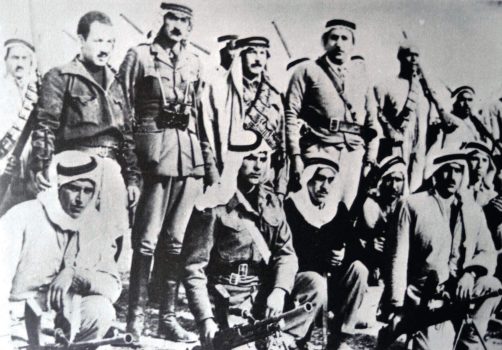 —Ibrahim Abu Dayya, commander of Army of Jihad, was born in 1917 in the village of Surif, by the Etzion Bloc. In World War II, he joined the regiment raised by the mufti of Jerusalem under Nazi command. In the War of Independence, Abu Dayya directed several successful battles, including that which destroyed the IDF’s 35th Regiment (the Lamed Heh) on the way to Jerusalem. The battle for Kibbutz Ramat Rachel left him a paraplegic. Abu Dayya (kneeling, in a black shirt) with other officers of the Army of Jihad, February 1948. Abd al-Qader al-Husseini is standing just behind him
—Ibrahim Abu Dayya, commander of Army of Jihad, was born in 1917 in the village of Surif, by the Etzion Bloc. In World War II, he joined the regiment raised by the mufti of Jerusalem under Nazi command. In the War of Independence, Abu Dayya directed several successful battles, including that which destroyed the IDF’s 35th Regiment (the Lamed Heh) on the way to Jerusalem. The battle for Kibbutz Ramat Rachel left him a paraplegic. Abu Dayya (kneeling, in a black shirt) with other officers of the Army of Jihad, February 1948. Abd al-Qader al-Husseini is standing just behind him
They decided to send a small, lightly injured group to seek shelter outside the monastery. Klaar chose who was to go, and Dado briefed these men. Once the contingent was out of sight, the defenders heard a barrage of gunfire that lasted far too long. Few reached the forces waiting for them in the Valley of the Cross.
Toward noon, with three-quarters of the defenders injured, the commanders had to decide whether to fight on or retreat. It was a life-or-death decision. If pulling back, they had to start preparing right away, before anyone else was hurt. If staying, it was to the end. Unable to choose between their troops’ lives and the fate of Jerusalem, they eventually radioed battalion commander Yosef Tabenkin. He told them to retreat.
But again, what were they to do with the wounded? Everyone knew how the bodies dragged from ambushed convoys had been mutilated; each could still picture comrades killed in the battle for Nebi Samuel just the week before. The fighters couldn’t allow those now lying in the infirmary to fall into enemy hands. Yet evacuating these patients would endanger everyone else.
It was decided that those with moderate injuries would be carried out on stretchers. Those who weren’t carrying their comrades would provide cover for the rest. The dead and the most severely injured would be left behind, but the commanding officers would blow up the infirmary, so those remaining would escape capture.
Klaar was to decide who would stay behind. Having experienced the infamous selection process at the gates of Auschwitz, he now had to choose which of his fellow fighters might live and which would die.
From the Jaws of Defeat
Feverish preparations began. Dynamite was laid under patients’ mattresses, to be detonated remotely. Everything was ready by 2 p.m., but just as the defenders were about to set out, Tabenkin’s voice came over the transmitter: the retreat had been cancelled.
Benny Marshak had been right; just when the Palmah fighters had despaired, the Arabs had as well. They’d also suffered heavy casualties, and could see no way of budging the Palmah forces. Furthermore, reinforcements sent from Hebron and Jerusalem had been ambushed by Jews from the Etzion Bloc. That afternoon, Palmah counterintelligence had intercepted wireless communications between the Arabs fighting in Katamon and their headquarters in the Old City. Commander Abu Dayya had left – ostensibly to bring reinforcements – and his men were requesting help and British intervention. They were on the verge of collapse. At the same time, Arab fighters were observed deserting Katamon. Tabenkin ordered both platoons to return to their firing positions and start shooting even more fiercely. As if in response, the Arab fire ground to a halt.
At five, with the Palmah troops still under fire, an infantry platoon from the Hagana’s Etzion Brigade arrived to relieve them. The dozens of Jewish reinforcements pouring into Katamon made the Arab forces there even more nervous, and they withdrew, together with what remained of the civilian population.
Katamon was in Jewish hands at last.
In his historical novel A Pigeon and a Boy, Israeli author Meir Shalev says of the battle for San Simon, “In the end we won, but it was one of those victories where the winner is more surprised than the loser.”
Even when it was over, the battle was not forgotten. Soldiers who fought with Rafael Eitan in the most difficult moments of the Yom Kippur War, when trying to block the Egyptian army advancing over the Suez Canal, remember him saying that when you’re cold and wet and the rain’s coming down, it’s coming down on the enemy too. Even at the worst point in the fighting, he didn’t ask Commander in Chief Dado Elazar for permission to retreat, because he knew the response he’d get – the same truth Benny Marshak had impressed on them both that night in San Simon. Raful said as much to the Agranat Commission during its investigation of the army’s performance in the Yom Kippur War:
I learned my life’s lessons from previous wars. When it’s tough for you, it’s also tough on the enemy, and whichever side manages to hold on just that bit longer in a tough situation will prevail. (Ronen Bergman and Gil Meltzer, The Yom Kippur War: Moment of Truth [Yedioth Ahronoth Books, 2003], p. 134 [Hebrew])
Eighteen soldiers fell in the battle for San Simon. The memorial erected in the park beside the monastery reads: “Here they lost their lives, but not their nerve.”
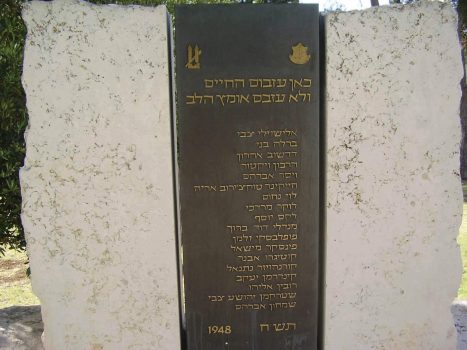 Photo: Dr. Avishai TeicherErected next to the monastery, this monument commemorates the Palmah fighters killed in the battle for San Simon
Photo: Dr. Avishai TeicherErected next to the monastery, this monument commemorates the Palmah fighters killed in the battle for San Simon
Further reading:
Benny Morris, 1948: A History of the First Arab-Israeli War (Yale University Press, 2009); Meir Shalev, A Pigeon and a Boy (Schocken Books, 2009)

